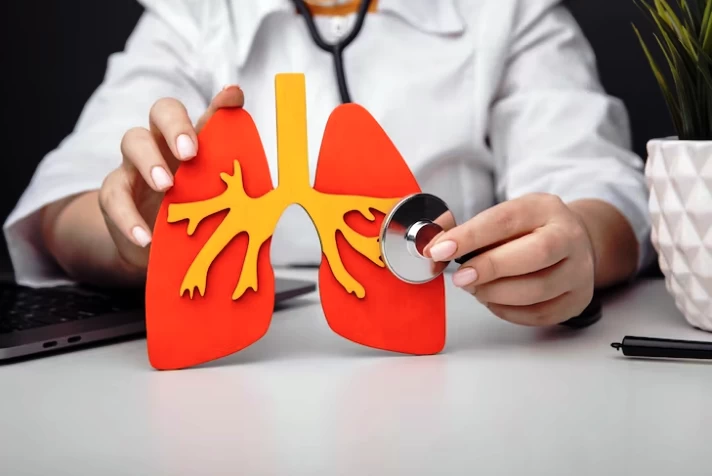Chronic Obstructive Pulmonary Disease (COPD) is a treatable and reversible condition characterized by airway narrowing, mucus plug formation, and impairment of the local immune system due to chronic inflammation in the airways. This inflammation is caused by harmful substances such as tobacco smoke, industrial fumes, infections, and aging. Although the progression rate of COPD is primarily determined by exposure levels, genetic and environmental factors also play a significant role. Globally, the most common cause of COPD is the use of tobacco products, which leads to the death of approximately 12,000 people every day.
What Are the Symptoms of COPD?
The symptoms of COPD include:
- Cough
- Sputum production
- Shortness of breath
- Fatigue
- Wheezing
- Chest tightness and pain
- Inability to perform daily activities
- Increasing difficulty in breathing
The main goals of COPD treatment are to alleviate symptoms, prevent disease progression, and mitigate complications such as cardiovascular damage, cerebrovascular damage, and damage to vital organs like the liver and kidneys, which may arise due to respiratory failure.
The human body fundamentally depends on oxygen for energy. Since COPD disrupts oxygen transport to the cells, it can potentially cause damage at the cellular level, playing a role in the development of various diseases.
What Are the Causes of COPD?
- Tobacco and tobacco products: The most common cause of COPD. In some cases, quitting smoking alone is sufficient for treatment.
- Air pollution: Chemical and toxic particles in the air cause chronic irritation and contribute to COPD.
- Genetics: Genetic factors play a role in COPD. The degree of harm from toxic exposure varies from person to person due to genetic predisposition. For example, a person who smokes 2-3 packs per day for 10-20 years may exhibit mild COPD symptoms, while another individual smoking only a few cigarettes per day for 5-10 years may develop severe COPD.
- Occupation: Jobs in mining, agriculture, construction, and chemical factories increase the risk of COPD.
- Infections: Recurrent lung infections and certain viral infections are linked to COPD development.
- Asthma: In rare cases, individuals with asthma, particularly those who smoke, develop COPD more quickly.
- Age: Advanced age is a risk factor due to the decline in the lung’s immune defense and the slowing of tissue repair mechanisms.
What Are the Treatment Methods for COPD?
Since COPD is a chronic and progressive disease, its treatment is long-term and requires dedication.
- Lifestyle modifications: Exercise, a diet rich in protein, antioxidants, and omega-3, adequate sleep, rest, and stress management are crucial for managing COPD, as with all chronic diseases.
- Smoking cessation: The fastest and most effective treatment approach.
- Bronchodilators: These medications widen the airways, improving airflow.
- Corticosteroids: Used to manage acute and chronic inflammation.
- Mucolytics and expectorants: Help reduce mucus production and facilitate mucus clearance.
- Oxygen therapy: Provides supplemental oxygen when respiratory failure develops.
- Pulmonary rehabilitation: Helps prevent muscle loss and reduced exercise capacity, facilitates mucus clearance, and improves mobility and activity levels in COPD patients.
- Interventional procedures: In cases of emphysematous COPD, bronchial valves can be used to eliminate non-functional lung areas. A newly developed treatment for COPD is Balloon Catheter Therapy.
Balloon Catheter Application in COPD
Among the interventional treatment options for COPD, a new technique involves bronchoscopy, a type of lung endoscopy. This method has shown effectiveness, particularly in advanced COPD and chronic bronchitis types.
The procedure is performed to widen narrowed bronchi, clear chronic mucus buildup, and improve respiratory capacity.
First, suitable patients are selected and undergo detailed examinations. If deemed appropriate, the patient is intubated under general anesthesia. Using a bronchoscope, a balloon catheter is inserted into all accessible bronchial pathways. The procedure takes approximately 2-3 hours in total. The balloon at the tip of the catheter inflates and deflates hundreds of times per minute, acting like a sanding tool on the bronchial walls.
The success rate of balloon catheter therapy varies depending on several factors, such as bronchial elasticity, the patient’s tissue regeneration capacity, continued tobacco use, and adherence to an antioxidant-rich diet. Based on these parameters, studies have shown an increase in lung capacity ranging from 20% to 80%.
Assoc. Prof. Dr. Özgür İNCE
Pulmonology Specialist


